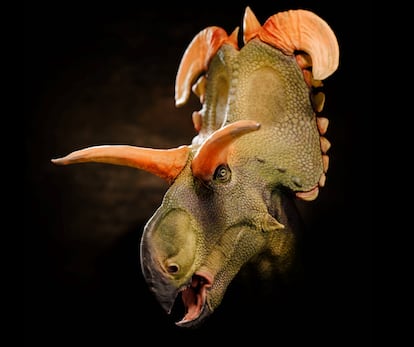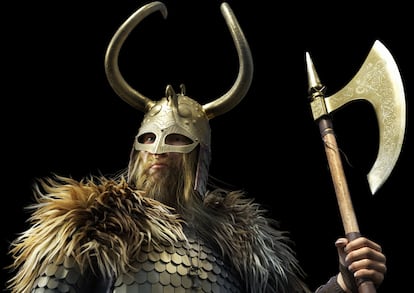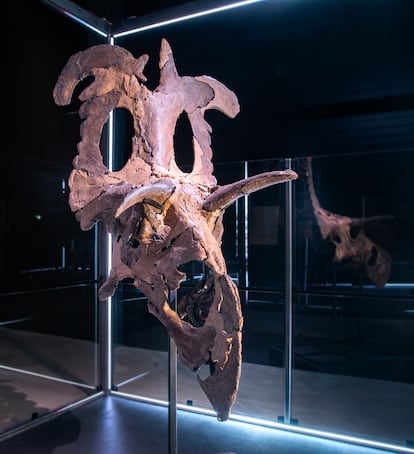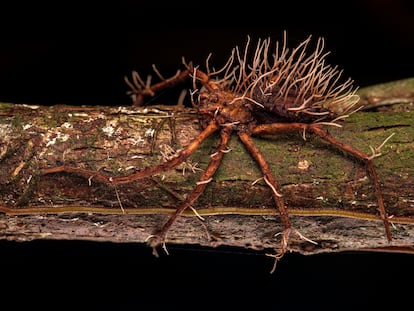Meet ‘Loki,’ the new dinosaur with giant horns that dates back 78 million years
The new species is the largest horned dinosaur ever discovered. It was 6.7 meters long and weighed around five tons

What do you get when you combine a controversial comic book character with a 78-million-year-old ancestor of Triceratops? Lokiceratops rangiformi. This newly discovered dinosaur has a very distinctive feature: a unique array of head ornaments, including the largest horns ever seen. The species name, announced June 20 in the scientific journal PeerJ, translates to “Loki’s horned face that looks like a caribou.”
The dinosaur was discovered, identified and named by Joseph Sertich from Colorado State University and Mark Loewen from the University of Utah. The two authors named the new species after the unusual, blade-like antlers on its frill — the shield of bone at the back of the skull — and the asymmetrical reindeer-like horns at the peak of the frill. These head ornaments also resembled the helmet that belonged to Loki, the charismatic trickster from Marvel comic books and movies, who was inspired by a Norse god of the same name.
The fossil remains were found in 2019 on private property near the Canadian border in the U.S. state of Montana. The researchers reconstructed the dinosaur using fragments the size of dinner plates or even smaller. Once they had pieced the skull together, they realized that it was a new species. Reconstructing and identifying the remains was the biggest challenge, says paleontologist Joseph Sertich. “The description of the skull, one of the most detailed ever written, and comparisons with other horned dinosaurs around the continent took an additional year,” he says
Loki is thought to have lived about 78 million years ago. According to the study, it was 6.7 meters long and weighed around five tons. During its lifetime — some 12 million years before its more famous relative, Triceratops — it made its home on an island continent called Laramidia, now in North America. Several specimens of the Ceratopsidae family have been found there. “This is the first time interval where five horned dinosaurs have been found living in the same place and time,” says Sertichm. The discovery is a new development in evolutionary research, indicating that a group can evolve rapidly from a common ancestor in a small region. “This is totally unexpected,” he says.
What the horns tell us about dinosaurs
Flirting and fighting. These are the two main functions of dinosaur horns. Head ornaments were used to attract the attention of potential mates, as a display of strength and health. Other theories suggest that horns were used to confront other individuals of the same species or to protect these herbivores from attacks by carnivores. Some research suggests that the Triceratops fought each other using their heads, as deer, goats and antelopes do today.



Centrosaurinae — the subfamily of horned dinosaurs to which the new specimen belongs — is known for sporting extravagant, showy head adornments. But Loki has several unique features. For example, it has no horn on its nose, and instead huge, curved, blade-like horns on the back of its frill and an asymmetrical spike in the middle. These were used more for display than defense, says Sertich. It was the largest horned dinosaur of its time.
According to the researchers, the region where Lokiceratops was found would have been a seasonally wet subtropical coastal plain, covered in lush forests mixed with open scrub and swamps. This hothouse world was the perfect environment for these animals for almost 20 million years, with plant productivity supporting at least five species of horned dinosaurs at the same time, along with similarly sized, duck-billed herbivores. “These skull ornaments are one of the keys to unlocking horned dinosaur diversity and demonstrate that evolutionary selection for showy displays contributed to the dizzying richness of Cretaceous ecosystems,” Sertich said in a press release.
After being discovered, many fossils are sold to museums for their aesthetic value as beautiful pieces of natural history, says Sertich. Now Loki’s remains are on display at the Museum of Evolution in southern Denmark. “This museum values science and research as much as it values exhibitions. It’s incredibly important that discoveries like this go to museums that care about public access to collections and access to fossils for study,” he adds.
Sign up for our weekly newsletter to get more English-language news coverage from EL PAÍS USA Edition
Tu suscripción se está usando en otro dispositivo
¿Quieres añadir otro usuario a tu suscripción?
Si continúas leyendo en este dispositivo, no se podrá leer en el otro.
FlechaTu suscripción se está usando en otro dispositivo y solo puedes acceder a EL PAÍS desde un dispositivo a la vez.
Si quieres compartir tu cuenta, cambia tu suscripción a la modalidad Premium, así podrás añadir otro usuario. Cada uno accederá con su propia cuenta de email, lo que os permitirá personalizar vuestra experiencia en EL PAÍS.
¿Tienes una suscripción de empresa? Accede aquí para contratar más cuentas.
En el caso de no saber quién está usando tu cuenta, te recomendamos cambiar tu contraseña aquí.
Si decides continuar compartiendo tu cuenta, este mensaje se mostrará en tu dispositivo y en el de la otra persona que está usando tu cuenta de forma indefinida, afectando a tu experiencia de lectura. Puedes consultar aquí los términos y condiciones de la suscripción digital.
More information
Archived In
Últimas noticias
The metaverse, four years later: Is it finished or just at a standstill?
$3,000 and a plane ticket: The United States increases incentives for migrants to self-deport before the end of the year
Charles Dubouloz, mountaineering star, retires at 36 with a farewell tour inspired by Walter Bonatti
From the White House to diplomatic gifts: Lego wins over adult fans, brick by brick
Most viewed
- The low-cost creative revolution: How technology is making art accessible to everyone
- Families demand repatriation of bodies of Colombians who died in Ukraine: ‘This war is a slaughterhouse for foreigners’
- Christian Louboutin: ‘Young people don’t want to be like their parents. And if their parents wear sneakers, they’re going to look for something else’
- Christmas loses its festive spirit: ICE fears cast shadow over religious celebrations
- Liset Menéndez de la Prida, neuroscientist: ‘It’s not normal to constantly seek pleasure; it’s important to be bored, to be calm’










































